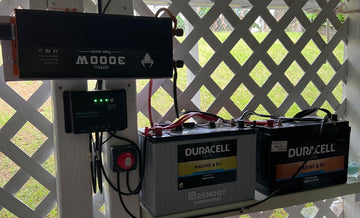A battery inverter, a key device in a solar power system, converts the direct current (DC) generated by photovoltaic solar panels into alternating current (AC). Most appliances and equipment require AC power to function properly, so inverters are necessary for powering common appliances in a home, boat, or RV. There are two common types of inverters on the market: pure sine wave inverters and modified sine wave inverters.
This comprehensive guide takes an in-depth look at the differences between pure and modified sine wave inverters, highlighting the technical differences, practical implications, and best applications for each type of inverter. You will gain valuable insight from the articles and be able to choose the right inverter for your needs.
The basic working principle of inverter
To understand the different types of inverters, you need to know how they work, which is divided into the following stages:
Rectification Stag
The DC input to the inverter is first converted to pulsed DC by a rectifier (usually a diode or SCR, etc.).
Intermediate Capacitor
After rectification, the pulsed DC is filtered by an intermediate capacitor to smooth the voltage waveform.
Inverter Circuit
The inverter circuit usually contains a set of power semiconductor devices (such as transistors or power MOSFETs) and control circuits. Filtered DC power enters the inverter circuit and is converted to AC power, producing different types of AC waveforms. The waveforms depend on the design and application of the inverter, e.g., pure sine wave, modified sine wave, etc.
Pulse Width Modulation
PWM modulation adjusts the pulse width of the output waveform according to the input signal's amplitude and frequency to control the output AC's voltage and frequency.
Output Filter
Inverters usually include an output filter to reduce harmonics and noise in the output waveform. It helps to bring the AC waveform generated by the inverter closer to the desired target waveform and improves the quality of the output voltage.
Control System
Inverters are usually equipped with a control system that monitors parameters such as input current, output voltage, and frequency, and adjusts the inverter's operating status as required. The control system ensures the stability and safety of the inverter while meeting the needs of different loads.
In brief, DC power is fed into the inverter, and, having passed through the semiconductor component, it is divided into a series of pulse signals that are filtered and adjusted to produce AC power with the same frequency, amplitude, and waveform as the desired output. Inverters are widely used in solar power generation, industrial applications, domestic appliances, transportation, communications, and many other fields.
What are pure sine wave inverters?
The output of a pure sine wave inverter is close to an ideal sine wave, providing a smooth periodic oscillation, a waveform that produces accurate power conversion. Pure sine wave inverters are therefore very gentle on sensitive equipment and are ideal for many applications such as medical equipment, precision instruments, communications equipment, etc. It delivers cleaner, smoother, higher-quality power to equipment.
In household grids, the power supply is usually in the form of a pure sine wave. To meet the needs of all types of installations, TOPBULL offers a wide range of pure sine wave inverters with different capacities.

What are modified sine wave inverters?
Unlike a smooth pure sine wave, a modified sine wave has a waveform that resembles a series of steps, with the polarity alternating back and forth between positive and negative. This makes modified sine wave inverters susceptible to power fluctuations. Their intermittent waveform can cause damage to delicate and sensitive equipment such as medical equipment, CPAP machines, etc.

Difference between pure sine and modified sine inverters
Waveform

It is clear from the comparison graph that, unlike a smooth pure sine wave, a modified sine wave has a square wave or pulse at the end and the waveform is discontinuous in the articulated part. The pure sine wave only makes brief contact at the top and bottom and does not stay for long. A modified sine wave, on the other hand, may linger at the top and bottom for a while, rather than moving immediately to the next extreme point. The length of time the waveform stays at the top and bottom can have some effect on the power consumption of the electronics or system:
Longer times at the top and bottom can cause electronic components to heat up due to continued power consumption. Elevated temperatures can affect component performance and longevity.
Any device with a microprocessor will use sine waves as part of its processing, and block waves can confuse the processor and cause it to malfunction.
Use cases
Pure sine wave inverters are very complex to design but are ideal for a wide range of applications. This is due to its high-quality output waveform and stability, which is essential for sensitive electronic equipment. It produces near-perfect true sine wave AC power, allowing equipment to run efficiently and stably without noise or interference. Below are examples of where a pure sine wave inverter is required:
- Medical equipment
- Communication base stations
- Laboratory equipment
- Audio equipment
- Home appliances
Modified sine wave inverters are economical due to their less complex design. Modified sine wave inverters have higher harmonic distortion and can therefore cause a humming noise when the inverter is used to power AC equipment. It is generally used in lower-end applications:
- Camping and outdoor activities
- Small offices
- Older CRT televisions
Sometimes your unit may have a higher-than-normal internal temperature, even though it appears to be operating well with an improved light trap. Excessive temperatures reduce the efficiency of the power supply, which can hurt the unit over a long period.
Cost
Pure sine wave inverters are more technologically advanced, with complex circuit designs and high-quality internal components that undoubtedly increase manufacturing costs. Compared to a modified sine wave inverter of the same power, the price of a pure sine wave inverter is approximately 30-60 percent higher. However, the rigorously tested and quality-controlled pure sine wave inverters are of higher quality and have a longer lifespan than modified sine wave inverters, which are replaced more frequently. It is, therefore, more cost-effective in the long run to use Pure Sine Wave inverters.
The 3000W Pure Sine Wave inverter uses pure copper high-frequency transformers and ultra-flexible cables and is capable of delivering 100% continuous power with a peak surge power of up to 6000W. In addition, inverters purchased from TOPBULL, whether Pure Sine Wave or Corrected Sine Wave, come with a minimum of one year warranty and 24-hour online customer service.

Pros and Cons of pure sine inverters
Pros
- High-quality output: produces a smooth sine wave, similar to that of a household socket.
- Good compatibility: suitable for almost all electrical equipment
- High stability: stable waveforms for sensitive and sophisticated electronic equipment
- Long life
Cons
- High price: expensive to manufacture
Pros and Cons of pure sine inverters
Pros
- Affordable: fewer parts, lower manufacturing costs
- Relatively high conversion efficiency: allows more efficient use of input power
Cons
- Electromagnetic interference: produces a humming noise when in use
- Poor waveform quality: may not work well with some equipment and may even damage it
Comparing the advantages and disadvantages of these two inverters, it is clear that: for applications with high power quality requirements and high demands on the stability of the equipment, the pure sine wave inverter option may be suitable; whereas for simple applications such as general household appliances, the advantages of the pure sine wave inverter are not obvious and the modified sine wave inverter may be a more cost-effective option.
Which one should you get? Pure sine or Modified sine?
To give you a better idea of what to choose, we've listed some common electrical appliances.
| Device | Pure Sine wave | Modified Sine Wave |
| Older CRT televisions | ✔️ | ✔️ |
| Printers | ✔️ | ✔️ |
| Coffee machines | ✔️ | ✔️ |
| Toasters | ✔️ | ✔️ |
| Electric kettles | ✔️ | ✔️ |
| Electronic clocks and watches | ✔️ | ✔️ |
| Light bulbs | ✔️ |
✔️ but buzzing noises |
| Laptops | ✔️ |
✔️ but shorten battery life span |
| Refrigerator | ✔️ | ❌ |
| Microwave Oven | ✔️ | ❌ |
| Electric Heater | ✔️ | ❌ |
| Medical equipment | ✔️ | ❌ |
Conclusion
Pure sine wave inverters are a more advanced technology with a high initial investment cost but a long service life. Using a modified sine wave inverter to power some simple electrical appliances is still a viable option and can do the job well. Choose the inverter that best suits your situation.
FAQs
Q: Can I use a modified sine wave inverter?
A: There is no problem at all in using a modified sine wave inverter in a simple electrical device together. You can check with the manufacturer before using it to clear
Q: Which is better, pure sine wave or modified sine wave inverter?
A: Both of these inverters have advantages and disadvantages that you can choose based on your specific needs
Q: Why are pure sine wave inverters more expensive?
A: Pure sine wave inverters are more technically complex and have more expensive materials, so they are generally more expensive, but they have higher efficiency and compatibility. In most cases, a pure sine wave inverter costs between $100 and $600.

















